It’s draft season everybody, one of the most beautiful times of the year. Scrutinizing every single pitch of spring training, tricking ourselves into believing this is TOTALLY gonna be the year for [PLAYER NAME], you just gotta believe!
It’s also the time of year when everybody puts out their draft prep articles and starts talking about their big sleepers for the year. In this article, I’m going to be doing exactly that — it’s one of my favorite articles series to write and this is the fifth edition of it (which is crazy!).
So here’s how this article works — I’m listing guys here who currently have an NFBC ADP of 250 or higher, meaning these are guys in your 10- and 12-team leagues that will likely be going toward the end of drafts or maybe even right at the end of the draft.
When you’re drafting, I believe it’s important to remember that the last few rounds are not for guys who are going to give you middling production from your bench, but for fliers — players who have a high ceiling that you want to take a shot on. These players are the types that could help propel you to a championship, and the beauty is, if they don’t work out, you can just drop them for whoever you want on the waiver wire, and all you lost was a late-round pick. And you’re likely going to know relatively quickly whether some of these guys are going to pan out or not.
It’s important to note that I’m not saying these guys in this article are suddenly going to be league winners. Like I said, it’s possible, they might be, but you’re rolling the dice here. These are guys who I think have the opportunity and the talent to turn into fantasy assets.
Anyway, let’s dive into the darts I’m throwing in drafts this year!
Honorable Mention: Byron Buxton (ADP: 240)
I’m slightly cheating with this one because Byron Buxton’s ADP isn’t quite 250 but it’s close enough and I’m the one writing the article so I get to make the rules.
The story of Byron Buxton has always been mountains of potential constantly marred by injuries — he played 140 games back in 2017 and since then has played 92 games at most. But that’s not to say Buxton hasn’t been productive — in fact in that 92-game season in 2022 he hit 28 home runs, albeit while batting .224, but still, there was production to be had.
But last year was rough. Buxton only played in 85 games and slashed .207/.294/.438 with 17 home runs, 49 runs, 42 RBI, and nine steals and ultimately needed to undergo surgery cleaning up scarring from his 2022 knee surgery.
But here’s the thing: despite the disappointing results, Buxton still generally made good decisions at the plate last year and had really good power.
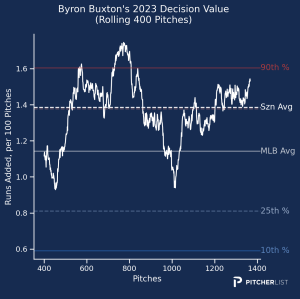
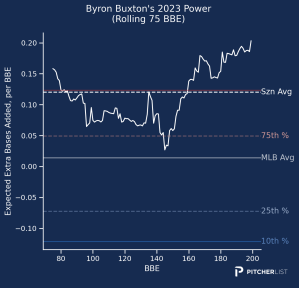
And on top of that, all the reports out of Twins spring training is that Buxton is healthy and feeling better than ever and wants to steal 30 bases this year. But I mean, fool me once fool me twice, right?
Here’s the thing though — unlike past years, you don’t have to pay a premium to draft Buxton this year. His ADP is right around 250, meaning he’s going in the latter half of most drafts. That means you likely already have a couple of outfielders and can stomach the risk of grabbing Buxton without it tanking your team.
It’s a great low-risk, high-reward play. If you grab Buxton and he gets hurt again and basically has a season like last year, then you wasted, what, a 20th, 21st round pick on him? You had to miss out on Shea Langeliers or Whit Merrifield?
But if there’s an off-chance that these reports are right, that Buxton really is fully healthy playing out in center field every day, the ceiling is still pretty high. The skills are clearly still there — he was on roughly a 25-30 home run pace last year given a full season.
Late-round picks are all about upside. As our own Nick Pollack has said many many times, you’re not drafting a best ball league (unless you actually are). You don’t need to grab some mediocre guy because the projections say he’ll do okay for your team. Later in the drafts is where you’re chasing upside — if it works out, it could help win your league, if it doesn’t work out, you’ll dump him for someone on the waiver wire anyways.
Buxton is a huge upside play, and you don’t have to pay too much to draft him, so why not roll the dice?
Kyle Harrison (ADP: 260)
When you’re looking for upside pitchers late in drafts, oftentimes it’s good to look at pure stuff. Draft a guy who’s got nasty stuff but some other flaws, because it’s those guys who are more likely to break out.
Kyle Harrison definitely has stuff, and PLV is a fan of both his fastball and curveball.
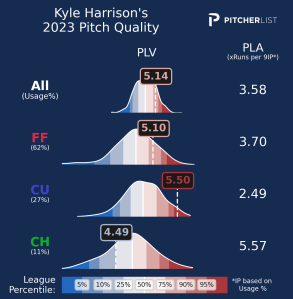
He’s got a fastball with elite VAA and excellent extension, which helps make up for the fact that it averages 94 MPH. And even better, Harrison locates it up in the zone pretty consistently, with a 55.2% hiLoc last year. What a great fastball right? For the most part, yes, but there are two concerns: First, Harrison had trouble locating it in the zone consistently, with just a 46.8% zone rate. And second, the pitch wasn’t great against lefties. Last year, righties had a .226 wOBA against the pitch. But lefties? They had a .450 wOBA against it.
As for his curveball, it comes in around 82 MPH on average with lots of vertical break and was frequently used both against lefties and early in counts to steal a strike, which it was good at, with a 23.7% called strike rate, good for 78th percentile in the league. Meanwhile, the changeup was Harrison’s main swing-and-miss pitch with decent numbers there — including a 46.7% chase rate, but it also came with a 43.8% ICR.
Basically, all of this is to say, the stuff is there, but there’s refinement that needs to happen. Luckily, Harrison has looked pretty good in spring training so far, pitching to a 2.08 ERA with six strikeouts in 4.1 innings. It’s the smallest of small sample sizes, but at this point in your draft, you’re chasing upside, and Harrison has it. The fastball is legit and if he can refine his curveball and/or changeup, or if this new cutter that he’s added really works well, he could be pretty good.
Kutter Crawford (ADP: 267)
We saw a good bit of Kutter Crawford last year with the Red Sox, as he pitched 129.1 innings through 31 games (23 starts) and pitched to a 4.04 ERA with a 25.6% strikeout rate. All perfectly okay numbers, so why are we talking about him here?
Because again, it’s about the stuff.
Crawford’s approach comes with a bunch of different pitches, but the one that’s most exciting is his fastball, which he throws around 39% of the time. It comes in around 94 MPH, which is fine, but it has a metric ton of spin on it, good VAA, and elite induced vertical break, and he locates it up in the zone a bunch (60.4% hiLoc last year).
These are all very good things, and here’s what’s even more fun — Crawford’s fastball logged a 35.7% chase rate and 14% swinging-strike rate last year, both of which are way high for a fastball, and it was even more effective against lefties, with a 16.6% swinging-strike rate and 36% chase rate. It wasn’t as effective of a pitch against righties (a 48% ICR from righties is a bit concerning), but it was still good.
Alongside that pitch, Crawford also has a kutter that’s both an effective swing-and-miss pitch (35.2% chase rate, 13.1% swinging-strike rate) and fairly good at inducing weak contact (30.8% ICR).
And then there’s his slider, which is even more impressive, with a 24.8% swinging-strike rate, 28.9% CSW, and a 30% ICR against it. Here’s a look at it:
Like I said before, you want to draft stuff this late in drafts, and Kutter’s got the stuff alongside a rotation spot. And through three starts in spring training, he’s looked pretty good, with a 1.13 ERA and seven strikeouts through eight innings.
Anthony Rizzo (ADP: 269)
Anthony Rizzo started off the year absolutely rocking, with a .304/.376/.505 slashline with 11 home runs through the end of May. And then he spent the rest of the season hitting .172/.271/.225 until he hit the IL with a concussion that ended his season.
Rizzo isn’t suddenly a terrible hitter. He’s still got good contact ability:
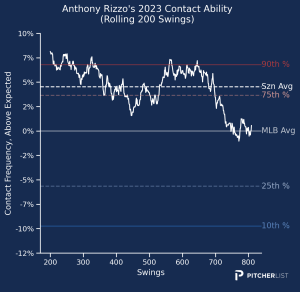
And it’s important to remember that just two years ago, Rizzo hit 32 home runs with 75 RBI and 77 runs. Now, he’s likely to be hitting fourth in the Yankees lineup behind both Juan Soto and Aaron Judge. If Rizzo returns to a similar output like the one he had in 2022, we’re talking about some big-time production.
It’s going to take a few weeks to see if things are really going to turn on for Rizzo, but even if they don’t the price is a draft pick somewhere between the 21st to 23rd round, depending on league size, and that’s a pretty low price to pay for the potential that a bounceback season from Rizzo in the middle of a good Yankees lineup could provide.
Parker Meadows (ADP: 281)
Talent and opportunity — those are the two things you want to look for in a late-round flier. Parker Meadows has both.
Between 113 games in Triple-A and 37 games in the majors, Meadows had 22 home runs and 27 steals, which is pretty exciting. And what’s more exciting, Meadows’s 11% walk rate in Triple-A held steady in the majors at 11.7%. It’s pretty common to see a talented prospect come up to the majors and see their walk rate plummet, but Meadows didn’t, which is super encouraging.
As you can see from our PLV metrics, Meadows showed good decision-making at the plate in the majors last year and had better-than-average contact ability:
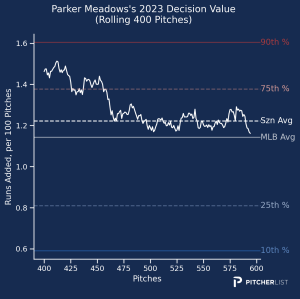
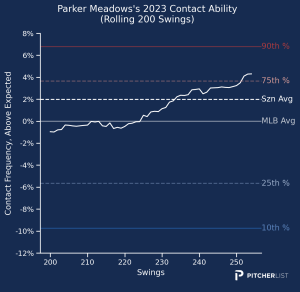
And thanks to that walk rate and contact ability, Meadows is likely to be the Tigers’ lead-off hitter. So there’s talent, and there’s opportunity. The ceiling for Meadows is probably something like a 20/20 guy with a solid average, but I think what you’re more likely to get is probably a 15/15 guy with a decent average.
This late in a draft, that’s not a terrible floor to go with what could be a pretty great ceiling.
Jordan Hicks (ADP: 307)
Jordan Hicks has always had impressive stuff, and he’s been an extremely GIF-able pitcher ever since he came into the league throwing 102 MPH sinkers. To this point, Hicks has always been a reliever, but now that he’s signed with the Giants, he’s going to be stretched out into a starter, and that is really interesting.
Hicks’ sinker averages 100 MPH, which is insane, and what’s more impressive is that he actually locates it relatively well, throwing it in the zone 51.6% of the time last year.
It’s an incredible pitch:
The guy throws some absolute gas, it’s amazing.
The sinker was exceptionally good at inducing weak contact with a 23.8% ICR last year, and it set up his slider well too, which sported a CSW over 38% last year and was quite good at making major leaguers look silly.
But this is where we run into trouble, and the questions about Hicks as a starter instead of a reliever start to pop up. Hicks basically was a two-pitch pitcher as a reliever — going with a sinker/slider approach. That can work a little bit as a starter, but you need more than a two-pitch approach to consistently be good.
There’s also the question of how effective Hicks can be throwing 96 or 97 on the sinker rather than constantly pumping 100, which is what we’re going to see as a starter — he can’t go max effort all of the time.
Still, the stuff is there, we know how nasty Hicks can be — he’s got the great sinker and a great slider — the question will be whether he can develop that third pitch and whether his sinker will still be consistently good at a lower velocity.
I think he’s worth a late-round flier, you’ll know within a couple of starts whether he’s got it going or not, and you can make a decision on what to do with him then. So far this spring, we’ve seen mixed results — he’s pitched 7.1 innings so far, giving up four earned runs, walking four, but also striking out 12.
Colt Keith (ADP: 314)
Before we dive in here, can we just take a moment to appreciate how fantastic of a baseball name Colt Keith is? I mean, it’s perfect. If you asked a computer to design a young baseball star, there’s a pretty high chance the name it would randomly generate would be Colt Keith.
Anyways, as it stands right now, Colt Keith is likely to be the everyday second baseman for the Tigers, and while that isn’t the greatest lineup in the world to hit in (though it’s far from the worst), Keith looked impressive in the minor last year.
Through Double- and Triple-A, Keith slashed .306/.380/.552 with 27 home runs, 88 runs, and 101 RBI. And it wasn’t one of those situations where Keith crushed Double-A and struggled in Triple-A, he was great in both, slashing .287/.369/.521 with 13 home runs in Triple-A through 67 games.
He’s not going to help you much in steals, but Keith has demonstrated good contact ability, good power, and good plate discipline in the minors. That’s basically all you can ask from a prospect, and as late as he’s going in drafts, it’s absolutely worth a flier to see if those skills from the minors translate to the majors.
DL Hall (ADP: 350)
As an Orioles fan, I’ve been watching DL Hall for a while now and the story has always been “filthy stuff, no control.” Hall never really got a consistent shot in the rotation for the Orioles mostly because he was blocked by a host of other pitchers by the time he was given consistent time in the majors, so he mostly just worked out of the bullpen. And given his filthy stuff, that worked (and to his credit, the control got a lot better last year).
But now, Hall is in Milwaukee, and given that he was one of the main pieces of the Corbin Burnes trade, they’re likely to give him a shot in the rotation, and that’s exciting.
The stuff is great — Hall has a fastball that averages around 96 MPH and comes in with great VAA and extension, and even better, he locates it up high a good bit, with a 54.8% hiLoc last year, something I’d love to see even more of this year.
Then, as secondary pitches, Hall has a slider and a changeup, and both look legit. Here’s the slider:
It comes in around 87 MPH on average with a good bit of movement to it and works well as a pitch breaking off the plate to lefties and down and in to righties.
And then there’s the changeup:
Which works well as a pitch to neutralize right-handers (and sported a 41% chase rate and 31.1% CSW last year).
So we’re looking at a young, former top prospect, who has a high-velocity fastball with good VAA and extension that he likes to locate up in the zone, and two legit secondary pitches that are effective weapons against hitters from both sides of the plate. As a flier towards the end of the draft, I’m all about it.
A.J. Puk (ADP: 360)
When A.J. Puk was first coming up with the Athletics as a top pitching prospect, it was thought he’d be a starter. That didn’t pan out though, but he’s turned out to be a pretty decent reliever over the years, with a few hiccups here and there.
But this year, the Marlins announced they’re going to stretch Puk out as a starter, and have been pitching him as such during spring training. As of now, it’s basically a guarantee that Puk will be in the rotation and I’m all about it.
Puk’s fastball is the bomb-diggity, coming in around 96 MPH on average with excellent VAA and elite extension and surprisingly, it works pretty well as a swing-and-miss pitch, posting a 28.4% chase rate and 38.4% CSW last year. Now, it wasn’t perfect, and Puk located it a little bit too much over the middle of the plate for my liking, which is likely one of the driving forces behind the 42.9% ICR the pitch had against it last year, but that can be adjusted.
And alongside that fastball, Puk has an awesome slider (or sweeper, whatever you want to call it) as well.
Last year the pitch posted a 33.3% chase rate, 18.1% swinging-strike rate, and 33.6% CSW, all numbers that are very good. And it was good at limiting hard contact, with a 32.7% ICR against it. Puk’s also throwing a splitter now, though it’s hard to get a good read on just how good of a pitch it will be since we’ve only had a few spring training games with it.
If you’re getting déjà vu it’s because Puk sounds a lot like what I was saying about DL Hall — a former top prospect who mostly worked out of the bullpen, has a nasty fastball and slider, and is now getting a consistent rotation spot. And you’re right, they are very similar, but with a couple of key differences.
First, I’m not nearly as concerned about Puk’s control as I am Hall’s. Puk has exhibited pretty good control in the past (he had a 5.4% walk rate last year, good for 91st percentile in the league) and I don’t see any reason he can’t as a starter.
Second, I’m not nearly as concerned about Hall’s stamina as I am Puk’s. Hall has only had a handful of bullpen appearances and was mostly a multi-inning reliever. Puk was a late-inning reliever and has logged a lot of time in the bullpen, so stretching out his arm is going to be more of a process than it is for Hall.
The stuff is clearly there for Puk — so far this spring training he’s yet to give up a run over 8.1 innings and has struck out 15 batters while walking four. The dude looks legit. The biggest questions are, will his splitter be a good third pitch for him and will he be able to consistently go more than five innings per game?
Either way, he’s worth the shot late in drafts.
Erick Fedde (ADP: 364)
Remember Erick Fedde? The guy who pitched for the Nationals for a while and not only kept giving up bunches of runs but also walked a lot of batters and didn’t strike people out? The guy who posted a 5.81 ERA over 27 starts in 2022?
Well, forget everything you know about Erick Fedde.
Now that you’ve done that, let me introduce you to this pitcher named Erick Fedde. He used to pitch in the majors and he was pretty bad, but he spent 2023 in the KBO and completely retooled his game, pitching to a 2.00 ERA, 0.95 WHIP with 209 strikeouts in 180.1 innings.
Now, he’s pitching with the White Sox and is looking to take this new approach — which includes a new splitter, a better slider, a four-seamer that hits 96 MPH, a cutter, and a sinker — and see if it works in Major League Baseball.
We’ve seen pitchers go to the KBO from MLB, change things there, have success, and then come back to MLB and pitch well (Merrill Kelly anyone?). This isn’t a guarantee of future success, but if you want to take a flier on Erick Fedde’s KBO success translating into some level of success in the majors, I think that’s a worthwhile investment.
We haven’t really been able to get a good look at Fedde in spring training yet, but you’ll know relatively quickly if this new Fedde is legit and you just snagged a quality fantasy arm at the end of your draft, or if Fedde is his old self that I just told you to completely forget about and in that case, you can dump him for someone on the waiver wire. Either way, it’s worth a shot.
Matt Manning (ADP: 411)
Matt Manning has loads of potential, but there are certain things in his game that need to be tweaked. Manning has a fastball that gets elite extension — 7.1 feet, which is good for 93rd percentile in the majors — and a super high VAA with pretty solid induced vertical break.
In theory, that should make for an elite, Zack Wheeler-type fastball, but the problem is, Manning’s fastball only comes in around 93 MPH on average and he locates it low in the zone way more than he should. Last year, Manning’s fastball had a loLoc of 34.5% (96th percentile in the league) and a hiLoc of just 38.2% (5th percentile in the league).
But good news friends — so far this spring, Manning has been locating that fastball up in the zone more and he’s been floating around 95 MPH (though in his most recent start, it was sitting closer to 94). That’s encouraging, especially because paired with Manning’s fastball is a nasty slider:
How nasty of a slider? Good enough for the best slider in all of baseball by PLV. The slider isn’t a whiff pitch, that’s important to note. Sure, its 28.7% chase rate and 12.9% swinging-strike rate are fine, but what makes this slider so good is how well Manning commands it.
Last year, Manning’s slider had a 53.4% zone rate, which is exceptionally high for a slider, and as a result, it turned in an 18.2% called strike rate (which is also quite high), helping guide it to a pretty solid 31.1% CSW.
It’s a pitch that Manning frequently used early in counts, and when hitters made contact with it, they didn’t do a whole lot with it. The pitch had a 31.9% ICR and a .275 wOBA against — it’s just a pitch that hitters couldn’t really do anything with.
And in more interesting Matt Manning-related news, it appears that Manning is tweaking his changeup, throwing more of a split-change than he did last year:
Matt Manning, changeups.
Manning has been calling his offspeed pitch a changeup, but he switched to a splitter grip, so his revamped changeup with more depth is actually a splitter. #Tigers pic.twitter.com/74zJ5PxMmm
— Evan Petzold (@EvanPetzold) March 9, 2024
Adding another weapon to his repertoire, especially one like a split-change that could be an effective tool for getting lefties out, is extremely intriguing, provided he can command the pitch well (and that remains to be seen).
It hasn’t been the best spring training for Manning so far, but that doesn’t necessarily mean he’ll be a dumpster fire during the season. He’s got the tools, the potential is there, and I think it’s worth the exceptionally cheap price he costs in drafts right now.
Jesus Sanchez (ADP: 413)
The appeal of Jesus Sanches is one thing and one thing only — power:

The guy has plenty of power, as evidenced by his 11.8% barrel rate and 45.1% ICR last year. “But Ben! He only had 15 home runs last year, where’s all that power?”
You’re absolutely right, and here’s the problem — Sánchez makes lots of bad decisions at the plate, which limits how many home runs he’s going to hit. But, that’s something that can be tweaked, and as I’ve said multiple times in this article, you’re taking fliers on guys based on raw talent and opportunity.
Sánchez has the talent to be a 25+ home run hitter who hits in the .250s. He’s also got the opportunity, as he’s likely to stick in the six-spot or around there for the Marlins all year as their right fielder (unless he massively implodes). So if you want to take a shot on a guy at the end of your draft who could boost your home run totals, Sánchez is your guy.
Coby Mayo (ADP: 494)
This is a pick that might cost you a bench spot for a little while, depending on what the Orioles do, but it could also pay off in a big way.
Coby Mayo is the No. 30 prospect in all of baseball for MLB Pipeline, and the man can hit. Last year in 140 games between Double- and Triple-A, Mayo slashed .290/.410/.564 with 29 home runs, 84 runs, and 99 RBI alongside 15.1% walk rate.
And so far in spring training, Mayo has kept the train a-rollin’, slashing .313/.421/.563 with a 13.2% walk rate through 15 games so far.
Basically what I’m saying is, Coby Mayo is making it really hard for the Orioles to say he needs to be in the minor leagues this year. Now, that won’t necessarily stop them from doing it for a couple of reasons — Jackson Holliday is also slashing .323/.344/.613 in spring training after dominating the minors last year and is making an equally strong case to be in the majors this year.
And that creates a bit of an issue because the Orioles have a serious log jam in their infield. For their four infield positions, they’ve got (deep breath):
- Ryan O’Hearn
- Ryan Mountcastle
- Ramón Urías
- Jorge Mateo
- Jordan Westburg
- Gunnar Henderson
- Jackson Holliday
- Coby Mayo
- Connor Norby
- Terrin Vavra
And for whatever reason they also signed Kolten Wong and Nick Maton.
Now, to offer a bit of clarity on some of those names — Gunnar is locked in, as is Mountcastle. O’Hearn is learning the outfield and may end up doing a first base and/or outfield platoon. Connor Norby is likely to stick around in the minors, Terrin Vavra is a non-factor for now (and can also play the outfield), and I can’t imagine Wong or Maton doing much of anything (but who knows, I also didn’t expect O’Hearn to do anything last year).
But still, crossing off all of those names, that leaves some mix of third base, second base, and shortstop open for a mix of Mateo/Urías/Holliday/Mayo/Westburg (I mention third because Henderson could stay at third or pivot over to shortstop if necessary).
Short of some kind of trade happening, that’s a lot of players for very few positions. But the Orioles want to win now, clearly, and Urías and Mateo are not the keys to winning. But powerful rookie campaigns from Holliday and Mayo could be.
There’s a lot of uncertainty here. I could see the Orioles sending either Holliday or Mayo (or both) down to the minors to start the year, then bring them up in May or June after they wreck Triple-A. Or, alternatively, they could choose to move on from Urías and/or Mateo, move them to the bench, and have Holliday and/or Mayo up in the majors.
All of this is to say, Coby Mayo has a ton of talent as a hitter, and he’s really making a case to be up in the majors. We’ll have more clarity on what’s going on with Mayo as we get closer to the start of the season, but if you want to take a swing on him with your last pick in the draft, I think it’s worth the potential upside. And if he’s in the minors and you don’t want him burning a bench spot, then dump him and grab someone on the waiver wire.
Ryan Weathers (ADP: 706)
Sometimes we overreact to spring training numbers, but sometimes they’re a harbinger of things to come. The main thing to look for in spring training numbers is a noticeable skill change, so when you see that Ryan Weathers has a 1.32 ERA with 17 strikeouts and three walks through 13.2 innings so far this spring, you should be curious.
Weathers has been bad in the majors to this point. Last year in 57.2 innings he pitched to a miserable 6.55 ERA. But things are looking different this spring — Weathers has increased the velocity on his four-seamer and has improved his slider.
Weathers also has a rotation spot all but locked down right now, especially given his success so far this spring. With both Edward Cabrera and Braxton Garrett hurt, it’s likely that Weathers will get a chance for a good handful of starts, and if he’s able to translate his success so far this spring into success during the season, he could be a valuable fantasy asset, and he’s going so late in drafts, he’s basically free. Why not take a shot and see what happens?
Graphic adapted by Kurt Wasemiller (@KUWasemiller on Twitter / @kurt_player02 on Instagram)

